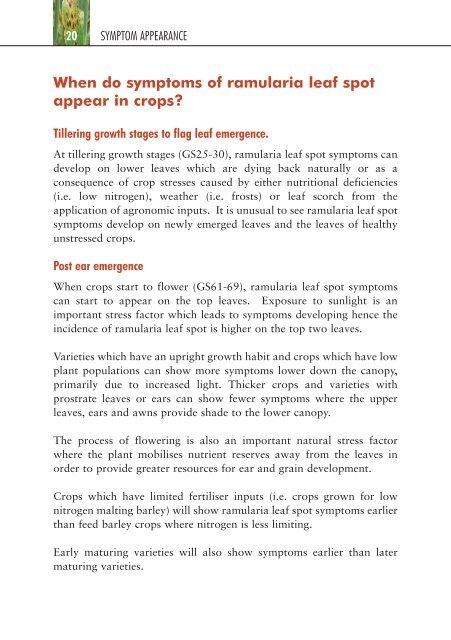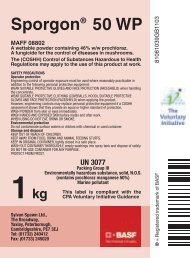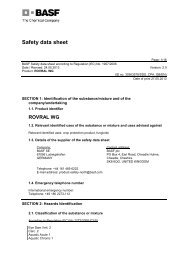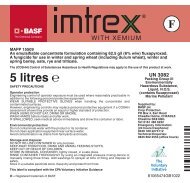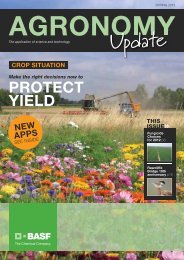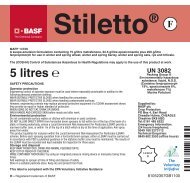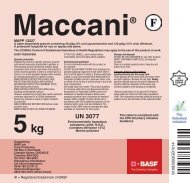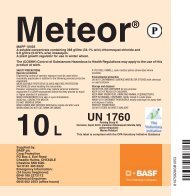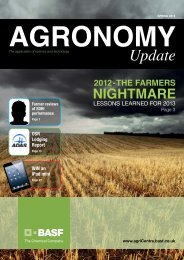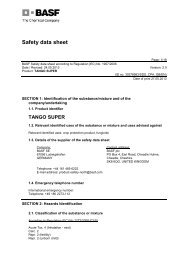a guide to the recognition and understanding of ramularia and other ...
a guide to the recognition and understanding of ramularia and other ...
a guide to the recognition and understanding of ramularia and other ...
You also want an ePaper? Increase the reach of your titles
YUMPU automatically turns print PDFs into web optimized ePapers that Google loves.
20<br />
SYMPTOM APPEARANCE<br />
When do symp<strong>to</strong>ms <strong>of</strong> <strong>ramularia</strong> leaf spot<br />
appear in crops?<br />
Tillering growth stages <strong>to</strong> flag leaf emergence.<br />
At tillering growth stages (GS25-30), <strong>ramularia</strong> leaf spot symp<strong>to</strong>ms can<br />
develop on lower leaves which are dying back naturally or as a<br />
consequence <strong>of</strong> crop stresses caused by ei<strong>the</strong>r nutritional deficiencies<br />
(i.e. low nitrogen), wea<strong>the</strong>r (i.e. frosts) or leaf scorch from <strong>the</strong><br />
application <strong>of</strong> agronomic inputs. It is unusual <strong>to</strong> see <strong>ramularia</strong> leaf spot<br />
symp<strong>to</strong>ms develop on newly emerged leaves <strong>and</strong> <strong>the</strong> leaves <strong>of</strong> healthy<br />
unstressed crops.<br />
Post ear emergence<br />
When crops start <strong>to</strong> flower (GS61-69), <strong>ramularia</strong> leaf spot symp<strong>to</strong>ms<br />
can start <strong>to</strong> appear on <strong>the</strong> <strong>to</strong>p leaves. Exposure <strong>to</strong> sunlight is an<br />
important stress fac<strong>to</strong>r which leads <strong>to</strong> symp<strong>to</strong>ms developing hence <strong>the</strong><br />
incidence <strong>of</strong> <strong>ramularia</strong> leaf spot is higher on <strong>the</strong> <strong>to</strong>p two leaves.<br />
Varieties which have an upright growth habit <strong>and</strong> crops which have low<br />
plant populations can show more symp<strong>to</strong>ms lower down <strong>the</strong> canopy,<br />
primarily due <strong>to</strong> increased light. Thicker crops <strong>and</strong> varieties with<br />
prostrate leaves or ears can show fewer symp<strong>to</strong>ms where <strong>the</strong> upper<br />
leaves, ears <strong>and</strong> awns provide shade <strong>to</strong> <strong>the</strong> lower canopy.<br />
The process <strong>of</strong> flowering is also an important natural stress fac<strong>to</strong>r<br />
where <strong>the</strong> plant mobilises nutrient reserves away from <strong>the</strong> leaves in<br />
order <strong>to</strong> provide greater resources for ear <strong>and</strong> grain development.<br />
Crops which have limited fertiliser inputs (i.e. crops grown for low<br />
nitrogen malting barley) will show <strong>ramularia</strong> leaf spot symp<strong>to</strong>ms earlier<br />
than feed barley crops where nitrogen is less limiting.<br />
Early maturing varieties will also show symp<strong>to</strong>ms earlier than later<br />
maturing varieties.


